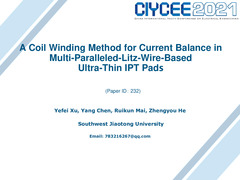A Coil Winding Method for Current Balance in Multi-Paralleled-Litz-Wire-Based Ultra-Thin IPT Pads
ID:247
Submission ID:232 View Protection:ATTENDEE
Updated Time:2021-12-10 10:56:23
Hits:1047
Oral Presentation

Start Time:2021-12-15 14:45 (Asia/Shanghai)
Duration:15min
Session:[E] Wireless power transfer technology » [E1] Session 5
Video
No Permission
Presentation File
Tips: The file permissions under this presentation are only for participants. You have not logged in yet and cannot view it temporarily.
Abstract
Inductive power transfer (IPT) technology can simplify the consumer electronic charging process, whereas the height and the volume of a consumer electronic are limited, and the thickness of the receiving pad is required to be thin. In this work, multi-paralleled Litz wires (MPLWs) are used to decrease the pad thickness. However, unbalance current problem in the MPLWs, leading to unbalance wire-losses and extra power loss on the receiving pad, cannot be ignored due to the differences among inductances, mutual inductances, and cross mutual inductances of the wires. Thus, a circuit model is established to analyze the unbalance currents. Then, a coil winding method is proposed to alleviate the unbalance currents. Finally, a 720 W prototype with an ultra-thin 2.5 mm receiving pad is built to validate the performance of the proposed approach. The results show that with the proposed method, both the phase differences and the amplitude differences among the currents flowing through the paralleled wires can be reduced, the standard deviation of the currents decreases from 1.46 A to 0.03 A, the currents become uniform, and the system efficiency is improved 1.1% from 93.1% to 94.2%.
Keywords
Speaker




Comment submit